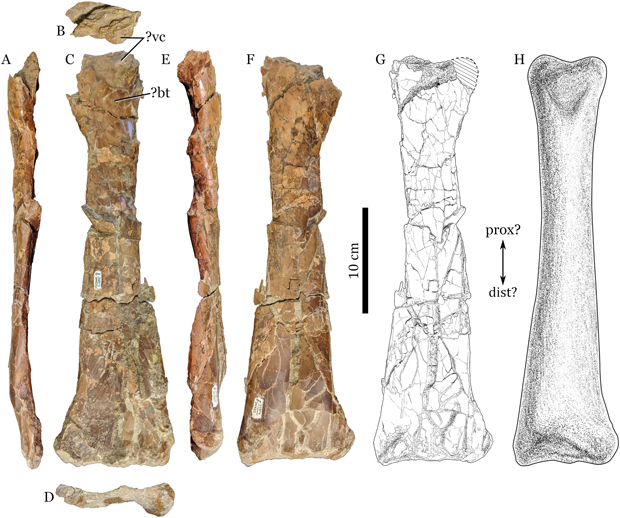Limb Bone Research Confirms Large Pterosaurs Across Laramida
Single Bone Suggests Large Pterosaurs Across Both North and South Laramidia
A single bone from a large pterosaur tentatively described as an ulna found in 2016 has confirmed the presence of large flying reptiles in terrestrial ecosystems in both north and south Laramidia during the Late Cretaceous.
Writing in the on-line, academic journal “PeerJ”, Dr Andrew Farke of the Raymond M. Alf Museum of Palaeontology (Claremont, California), reports that the 36 cm long bone from a bonebed within the middle unit of the Kaiparowits Formation (Utah), extends the distribution of large pterosaurs across terrestrial environments during the Campanian of western North America.
Views of the Single Pterosaur Bone with Accompanying Line Drawings
Picture Credit: Farke (PeerJ)
The picture above shows various views of the single pterosaur limb bone (specimen number RAM 22574). Dorsal (A), proximal (B) with anterior (C) and dorsal (D) views, whilst E and F represent ventral and posterior views. Line drawing (G) shows an interpretation of the posterior view with missing parts shaded and line drawing H shows a posterior view of the complete and restored bone. The large size of the bone has permitted Dr Farke to make an estimate of the wingspan of the pterosaur. He estimates that this bone came from an individual with a wingspan between 4.3 and 5.9 metres. This bone is the largest pterosaur fossil reported to date from the Kaiparowits Formation.
Based on these estimates, the Kaiparowits Formation specimen is roughly comparable in size to Cryodrakon boreas an azhdarchid pterosaur known from the Dinosaur Park Formation of southern Alberta, Canada which was formally named and described in 2019: The First Pterosaur Unique to Canada is Described Cryodrakon boreas.
Significant Pterosaur Fossil Finds Associated with Terrestrial Environments in Late Cretaceous North America

Major pterosaur fossil finds from late Campanian-aged terrestrial depositional environments in western North America.
Picture Credit: Farke (PeerJ) with additional annotation from Everything Dinosaur (silhouettes based on work from Naish and Witton)
Silhouettes are scaled to maximum estimates of wingspan for individual specimens. The silhouette for RAM 22574 shows the minimum (black) and maximum (green) size estimates for the specimen (4.3 to 5.9 metre wingspan).
The strata in southern Alberta (Dinosaur Park Formation) from which C. boreas comes from was laid down shortly after the portion of the Kaiparowits Formation associated with this single pterosaur bone. Thus, Dr Farke concludes that relatively large pterosaurs occurred in terrestrial ecosystems in both the northern and southern parts of Laramidia (western North America), during the late Campanian.
The scientific paper: “A large pterosaur limb bone from the Kaiparowits Formation (late Campanian) of Grand Staircase-Escalante National Monument, Utah, USA” by Andrew A. Farke published in PeerJ.


